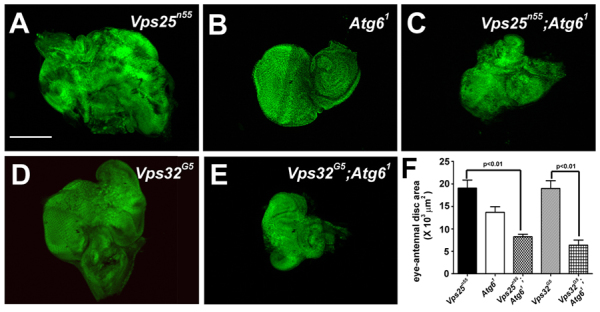Fig. 3.

Atg6 suppresses the Vps25 and Vps32 mutant eye phenotypes. (A) Vps25n55 mutant clone cells (GFP-negative) in late third instar eye imaginal discs cause non-autonomous over-proliferation of neighboring (GFP-positive) cells leading to overgrowth of the developing eye tissue (n=11). (B) Homozygous Atg61 mutant late third larval instar eye imaginal discs appear normal in size and morphology (DAPI is shown in green, n=10). (C) Homozygous loss of Atg6 suppressed overgrowth of the eye caused by Vps25 mutant cells (GFP negative) (n=6). (D) Vps32G5 mutant clones (GFP-negative) in late third instar eye imaginal disc cause non-autonomous overproliferation of neighboring (GFP-positive) cells leading to overgrowth of the developing eye tissue (n=11). (E) Vps32G5 mutant clones (GFP negative) in Atg61 mutant eye disc leads to suppression of overgrowth of the eye discs (n=10). (F) Quantification of eye-antennal disc area in each of the genotypes depicted in A-E. A two-tailed t-test was used for statistical analyses. The P-value between Vps25n55 and Vps25n55; Atg61 was 6.6×10-6 and the P-value between Vps32G5 and Vps32G5; Atg61was 1.97×10-5. Error bars represent s.d. Scale bar: 50 μm.
